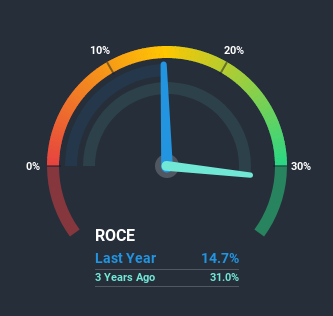- South Korea
- /
- Semiconductors
- /
- KOSDAQ:A183300
Here's What To Make Of KoMiCo's (KOSDAQ:183300) Returns On Capital
If we want to find a potential multi-bagger, often there are underlying trends that can provide clues. Ideally, a business will show two trends; firstly a growing return on capital employed (ROCE) and secondly, an increasing amount of capital employed. Put simply, these types of businesses are compounding machines, meaning they are continually reinvesting their earnings at ever-higher rates of return. Having said that, from a first glance at KoMiCo (KOSDAQ:183300) we aren't jumping out of our chairs at how returns are trending, but let's have a deeper look.
Return On Capital Employed (ROCE): What is it?
For those who don't know, ROCE is a measure of a company's yearly pre-tax profit (its return), relative to the capital employed in the business. To calculate this metric for KoMiCo, this is the formula:
Return on Capital Employed = Earnings Before Interest and Tax (EBIT) ÷ (Total Assets - Current Liabilities)
0.15 = ₩36b ÷ (₩324b - ₩80b) (Based on the trailing twelve months to September 2020).
Therefore, KoMiCo has an ROCE of 15%. In absolute terms, that's a satisfactory return, but compared to the Semiconductor industry average of 9.8% it's much better.
View our latest analysis for KoMiCo

In the above chart we have measured KoMiCo's prior ROCE against its prior performance, but the future is arguably more important. If you're interested, you can view the analysts predictions in our free report on analyst forecasts for the company.
What The Trend Of ROCE Can Tell Us
In terms of KoMiCo's historical ROCE movements, the trend isn't fantastic. To be more specific, ROCE has fallen from 22% over the last five years. On the other hand, the company has been employing more capital without a corresponding improvement in sales in the last year, which could suggest these investments are longer term plays. It may take some time before the company starts to see any change in earnings from these investments.
The Bottom Line On KoMiCo's ROCE
To conclude, we've found that KoMiCo is reinvesting in the business, but returns have been falling. Yet to long term shareholders the stock has gifted them an incredible 109% return in the last three years, so the market appears to be rosy about its future. Ultimately, if the underlying trends persist, we wouldn't hold our breath on it being a multi-bagger going forward.
KoMiCo does have some risks though, and we've spotted 3 warning signs for KoMiCo that you might be interested in.
While KoMiCo may not currently earn the highest returns, we've compiled a list of companies that currently earn more than 25% return on equity. Check out this free list here.
When trading KoMiCo or any other investment, use the platform considered by many to be the Professional's Gateway to the Worlds Market, Interactive Brokers. You get the lowest-cost* trading on stocks, options, futures, forex, bonds and funds worldwide from a single integrated account. Promoted
Valuation is complex, but we're here to simplify it.
Discover if KoMiCo might be undervalued or overvalued with our detailed analysis, featuring fair value estimates, potential risks, dividends, insider trades, and its financial condition.
Access Free AnalysisThis article by Simply Wall St is general in nature. It does not constitute a recommendation to buy or sell any stock, and does not take account of your objectives, or your financial situation. We aim to bring you long-term focused analysis driven by fundamental data. Note that our analysis may not factor in the latest price-sensitive company announcements or qualitative material. Simply Wall St has no position in any stocks mentioned.
*Interactive Brokers Rated Lowest Cost Broker by StockBrokers.com Annual Online Review 2020
Have feedback on this article? Concerned about the content? Get in touch with us directly. Alternatively, email editorial-team (at) simplywallst.com.
About KOSDAQ:A183300
KoMiCo
Provides semiconductor equipment cleaning and coating products in South Korea, the United States, China, Taiwan, and Singapore.
Good value with reasonable growth potential.
Similar Companies
Market Insights
Community Narratives




